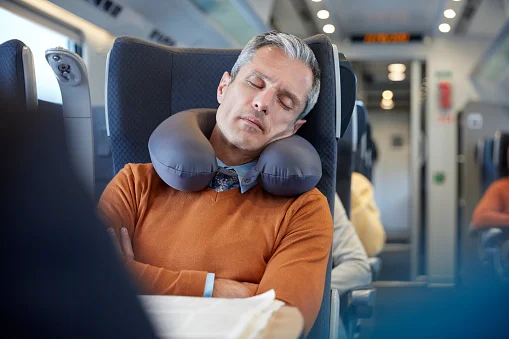How to Use a Travel Neck Pillow

Traveling is one of life’s most enriching experiences, but it often comes with a few unavoidable discomforts—especially during long flights, train rides, or road trips. One of the biggest challenges? Getting good rest while sitting upright for hours. That’s where the humble travel neck pillow comes in.
Though it might seem like a simple accessory, using a neck pillow the right way can be the difference between arriving refreshed or feeling stiff and groggy. In this article, we’ll explore how to properly use a neck pillow, why it matters, and what makes it such a game-changer for frequent travelers.
Why Use a Travel Neck Pillow?
Travel neck pillows are designed to support your head and neck in a neutral position, preventing awkward tilts and muscle strain when you’re sitting for extended periods. Unlike resting on a window or slumping forward, these pillows aim to align the cervical spine, reducing the chance of waking up with a sore neck or tension headaches.
They’re especially helpful during:
- Long-haul flights
- Overnight train journeys
- Road trips (as a passenger)
- Airport layovers
- Even quick naps at the office or while studying
Interestingly, some newer models of travel pillows are now designed with thoughtful features like memory foam, ergonomic shapes, and compact travel cases that make them more comfortable and easy to carry.
Do Travel Neck Pillows Actually Work?
Yes—but with realistic expectations. A travel neck pillow won’t magically provide the same comfort as a bed, but it can greatly reduce muscle strain, headaches, and post-travel fatigue. The key is choosing a high-quality pillow that suits your sleep style and learning how to position it correctly.
If you’re looking for a more supportive design, a travel neck pillow that wraps fully or includes side support might help maintain better posture during naps.
Types of Travel Neck Pillows
Before diving into how to use one, it’s worth understanding the different kinds available. Travel neck pillows have evolved beyond the basic U-shape you see in airport shops. Here are some common types:
U-Shaped Pillows
These are the most common. They wrap around the neck and are often filled with memory foam, microbeads, or inflatable material.
Wrap-Around or Scarf-Style Pillows
Designed for 360-degree support, these wrap fully around your neck and can provide more stability, especially for side sleepers.
Inflatable Pillows
Ideal for packing light. You can deflate them when not in use. Some models allow you to adjust firmness by controlling the air pressure.
Structured Pillows
These come with built-in chin or side supports that prevent your head from falling forward or sideways. Great for upright sleeping.
How to Properly Use a Travel Neck Pillow
Many travelers own a travel pillow—but few actually know how to use it effectively. Here’s how to get the most out of it:
- Choose the Right Orientation
Surprisingly, most people wear U-shaped pillows backwards. While it may seem natural to place the open end in front, turning it around so the thicker part supports your chin can offer better neck stability. This prevents your head from bobbing forward, especially when you fall asleep.
However, the correct orientation may vary based on pillow design. Some structured pillows are meant to be worn traditionally.
- Adjust for Height and Fit
If your pillow has an adjustable strap or toggle, use it! Tightening the fit around your neck prevents shifting during sleep. Your head should rest comfortably in a neutral position—neither tilted too far forward nor to the side.
For inflatable models, avoid over-inflating. A slightly softer pillow tends to be more comfortable and molds better to your neck.
Tips to Improve Sleep with a Travel Neck Pillow
Wearing the pillow properly is only part of the equation. Here are a few extra tips to make sure you actually sleep while traveling:
- Combine with a Sleep Mask and Earplugs
Blocking out noise and light helps your brain relax. A neck pillow, paired with a sleep mask and earplugs or noise-canceling headphones, can simulate a mini cocoon and make sleep easier.
- Support Your Lower Back
Adding a small lumbar pillow or rolled-up jacket behind your lower back improves overall spinal alignment, making it easier for your neck to rest in a neutral position.
- Try Side Leaning
If you’re in a window seat, lean against the side of the aircraft or train. Place your travel pillow between your head and the window for a cushioned surface. Some travelers even double up their pillows for extra support.
Hygiene Tips for Your Neck Pillow
Travel pillows often get tossed into bags, dropped on floors, or used during meals. That’s why a few simple hygiene practices can help:
- Use a washable cover
- Store it in a clean pouch or travel bag
- Avoid sharing it with others
- Wash or sanitize it after long trips
Final Thoughts
Traveling doesn’t have to come at the expense of comfort. Whether you’re a frequent flyer or planning your first cross-country road trip, using a travel neck pillow the right way can make a huge difference. It might not be the most glamorous accessory in your carry-on, but it could be the most valuable when it comes to arriving at your destination well-rested.
Remember, comfort during travel isn’t about luxury—it’s about preparation. And sometimes, a small accessory like a neck pillow is all you need to turn a tiring trip into a peaceful one.

Source: How to Use a Travel Neck Pillow




